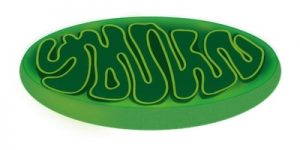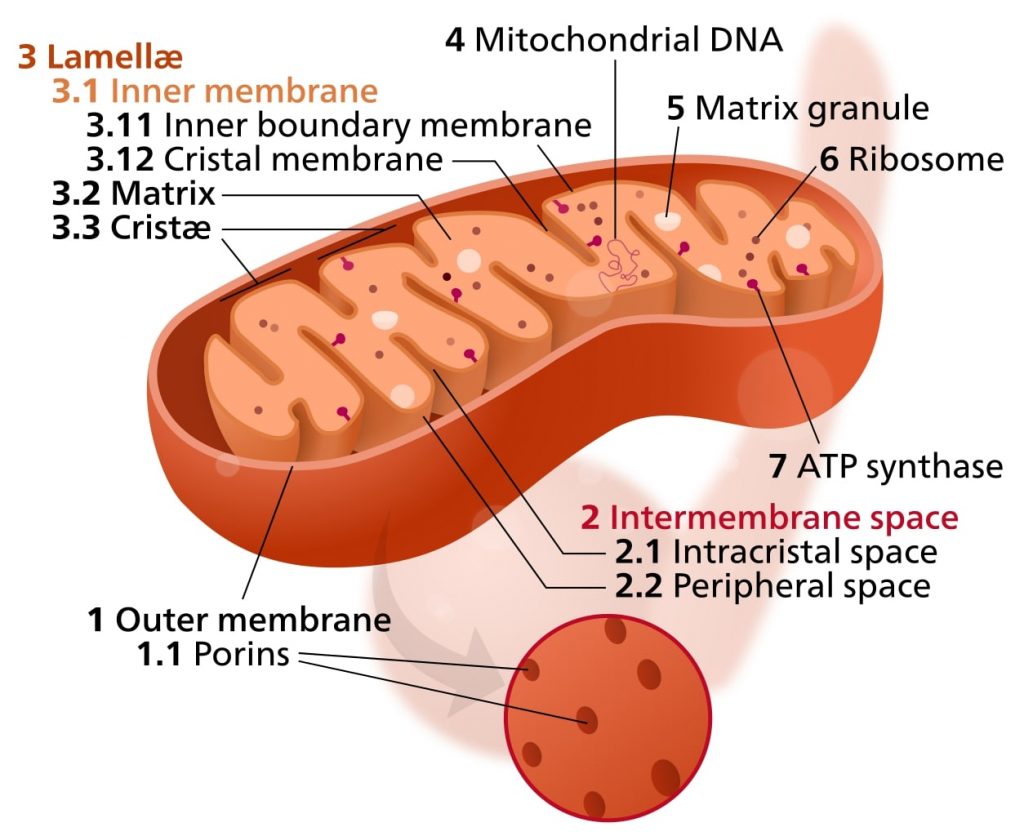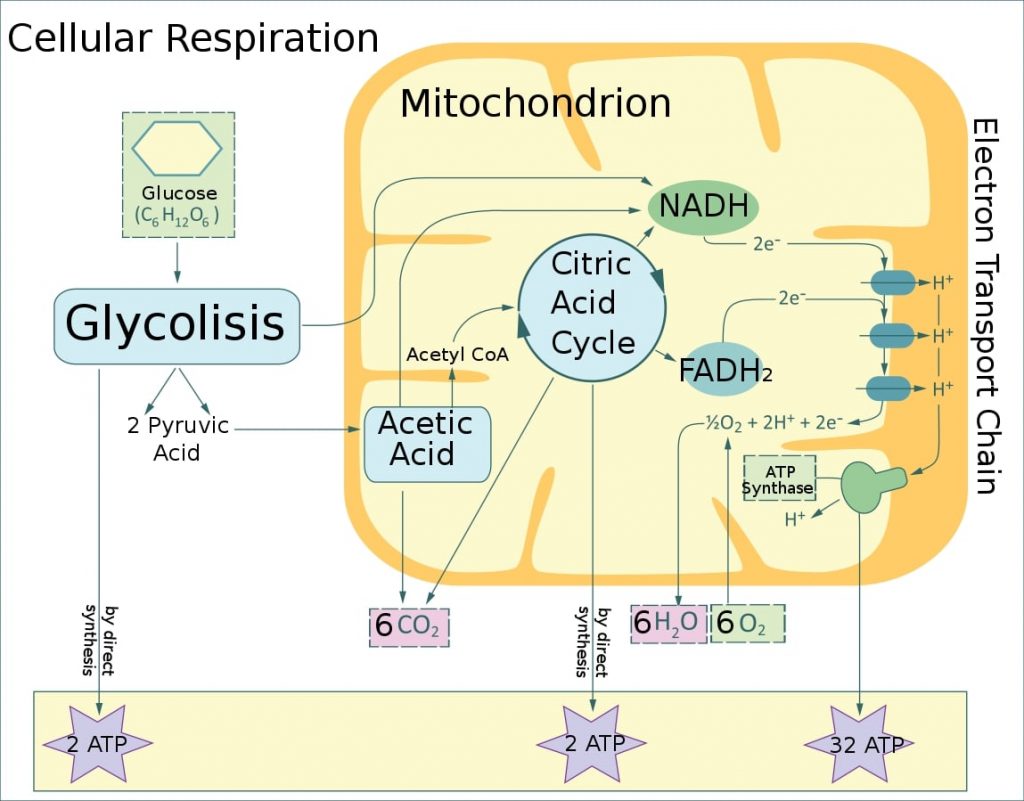Original article: Mitocondri: struttura, respirazione aerobica e malattie mitocondriali, by Alessandra Guglielmino
General characteristics
Mitochondria are located in eukaryotic cells and are a few micrometers in size. Eukaryotic cells contain hundreds of mitochondria, each wrapped in two membranes, called the inner and outer mitochondrial membrane. Mitochondria are also the house of small DNA molecules and essential proteins.

The mitochondrion contains enzymes and intermediates needed for cellular processes, such as the tricarboxylic acid cycle (TCA), fat oxidation, and ATP molecules’ synthesis. The chemical reactions of TCA and fat oxidation occur in the semifluid matrix, which fills the inside of the mitochondrion. To understand the function of mitochondria, let’s look at their location inside the cell, as they are directly connected.
Structure of mitochondria

The mitochondria have a bean-like shape, with a diameter between 0,5 -1 µm and a length of 1 – 4 µm. It is composed of two specialized and independent membranes. The outer membrane is the one that delimits the perimeter of the mitochondria. On the other hand, the inner one has several tubular folds and introflexion that are called crests, which are used to increase the surface of the membrane. In the middle of these two membranes, a space is created called intermembrane.
Inside the inner membrane we find the mitochondrial matrix that contains:
- The pyruvate dehydrogenase complex;
- β-oxidation enzymes of fatty acids;
- enzymes in the citric acid cycle;
- enzymes of the oxidation of amino acids;
- Ribosomes, the DNA;
- several soluble metabolic intermediates;
- other enzymes.
The membranes
Mitochondria’s membranes perform different functions and have different compositions. The outer is composed of lipids and proteins. Inside it contains several protein complexes, porins that act as membrane channels allowing the diffusion of molecules. The inner is composed of a lower portion of lipids but has a higher protein content than the outer membrane. The transport of molecules, in this case, is very selective, and membrane complexes mediate the transport of different molecules. Through selective channels called TIM (Translocase of Mitochondrial inner membranes), proteins destined to the mitochondrial matrix are transported.
Function
Mitochondria perform functions involving the metabolism of energy substances and the production of energy, including several processes. Some examples:
- Krebs cycle: also called the citric acid cycle, a process that originates in the mitochondrion, and through a series of reactions, it can complete the oxidation of organic substrates. Among the various molecules that enter this cycle is the Acetyl-CoA that oxidizes to carbon dioxide at the end of this cycle.
- Oxidative phosphorylation: in this process, the production of ATP molecules takes place, a vital source for all cellular functions. Higher-energy electrons are given over to electron transport chain complexes present on the crests, thus releasing energy for each transfer. Free energy is used to pump protons from the mitochondrial membrane to the intermembrane. After transit through the transport chain, electrons find themselves in lower energy and then are given to oxygen molecules. All the protons accumulated in the intermembrane return to the matrix, cross the channel of the enzyme ATP-synthetase and use the energy of the proton transfer to synthesize ATP molecules in the process of rotational catalysis.
Other functions of mitochondria include synthesis of the heme group, elongation of fatty acids, free radicals production, oxidation of adrenaline, homeostasis, apoptosis processes.
Role in aerobic respiration

Mitochondria play a very important role in aerobic respiration, the production of ATP takes place in this organelle. This process takes place in different stages:
- In the cytosol with glycolysis, the oxidation of glucose and sugars begins, producing pyruvate;
- pyruvate is transported through the inner mitochondrial membrane and then oxidized to acetyl-CoA within the matrix;
- Acetyl-CoA is the substrate of TCA;
- proton pumping and electron transport;
- proton energy is used to allow the synthesis of ATP.
The genome
The mitochondrion genome consists of a single, double strand of DNA (mtDNA) present within the matrix that, according to endosymbiotic theory, would derive from circular bacterial DNA. Mitochondria reproduction occurs independently through binary fission. The genome encodes part of proteins involved in mitochondrial metabolic processes and ribosomal and tRNA parts. Other proteins in mitochondria are encoded by nuclear DNA after synthesis and introduced into the mitochondria through membrane processes. One aspect not to be underestimated is that mitochondrial DNA is inherited exclusively by the maternal route. When fertilization occurs, the mitochondria found in the spermatozoa are eliminated, and therefore in the zygote (fertilized egg), all mitochondria derive from the mother. Thus, many hereditary diseases due to mitochondrial DNA defects are because the mother transmits them.
Mitochondrial diseases
Mitochondria have the important function of satisfying the energy needs of the organism. Defects in proteins in mitochondria can create congenital disorders of metabolism. Likewise, incorrect functioning of the mitochondrial chain or electron transport can lead to mitochondrial diseases. Such disorders may include the onset of different symptoms involving various body organs (brain, kidneys, muscles, heart, eyes). For many of these diseases, there is still no real cure. Only for some deficits is it possible to intervene (such as the deficit of coenzyme Q10, in this case, you can compensate with deficient substances).
Bibliography
- https://www.chimica-online.it/biologia/.htm
- https://www.osservatoriomalattierare.it/news/ricerca-scientifica?start=70
- Book, Becker, il mondo della cellula, Pearson
- Book, I principi di Biochimica di Lehninger, Zanichelli
- https://www.chimica-online.it/biologia/aerobico-e-anaerobico.htm
- https://www.osservatoriomalattierare.it/malattie-rare/malattie-metaboliche/11658-le-malattie-mitocondriali-rare-numerose-ed-eterogenee
- Featured image: wikimedia.org